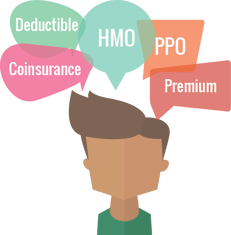 Would it surprise you to know that many millennials don’t know what coinsurance or a premium tax credit are? Or what the difference is between an HMO and PPO?
Would it surprise you to know that many millennials don’t know what coinsurance or a premium tax credit are? Or what the difference is between an HMO and PPO?
According to a recent study done at the University of Pennsylvania, today’s millennials are struggling to navigate the world of benefits. But who can blame them? Benefits enrollment is filled with insurance jargon and a plethora of choices that are difficult to navigate no matter what generation you belong to. But millennials in particular stumble when it comes to buying insurance—something we’re guessing they’re not chomping at the bit to buy.
The consensus from the study of millennials going through the enrollment process was, “It feels a little bit overwhelming because there’s so many different options.” We can imagine so, especially when you may not even understand deductibles or coinsurance. Clearly millennials need help enrolling in their benefits in a way that they can relate to, understand, and comes naturally to them. But what does that look like?
Simplify
Imagine going through your benefits elections in a foreign language. If you understand the language, it’s a walk in the park—you understand it, and so should everyone else. If you’re the one who doesn’t understand, however, you might be afraid to ask for help and instead be inclined to blindly throw your darts in hopes that you made the right decision. Benefits might not be an entirely different language, but if it’s your first time being exposed to the terminology, like many millennials are facing, the going is tough and the experience isn’t positive.
This is where decision support tools and recommendation engines come into play. MyChoiceSM by Businessolver, for example, strips the enrollment process of confusing insurance jargon to make enrollment manageable for everyone, whether it’s your first time enrolling, or you're a benefits expert. You don’t have to understand benefits lingo to make the right decision. It’s simple and straightforward—no guessing or research needed.
Engage
Buying insurance is an irrational decision. If you don’t understand what you’re buying (especially something you’re not looking forward to buying), it’s easy to make assumptions based on price. Some might automatically pick the least expensive plan to save money, others might pick the most expensive plan assuming that it will have the best coverage. But making decisions solely only on the cost of the plan doesn't provide a complete picture. What if you're underinsured and something happens, or you're over insured and paying for something you don't really need? These risks are personal factors that aren't included in a summary of benefits.
That’s where recommendation engines have the power to help your employees think about the bigger picture by asking questions that your employees may not be asking themselves. MyChoice asks 10 simple questions that combine financial risk, emotional risk and overall health to provide the best coverage recommendation for each employee.
The lack of knowledge in regards to benefits today means increased demand for effective benefits education and decision support. The technology is there, and employees expect it. What are you waiting for? Take a moment to learn more about our recommendation engine, MyChoice, and what it can do to help simplify the enrollment process and engage your employees in making better decisions.


